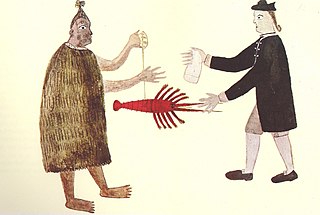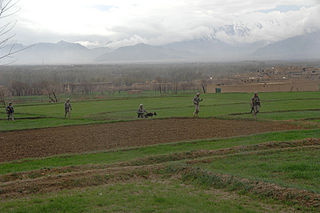
Guerrilla warfare is a form of unconventional warfare in which small groups of irregular military, such as rebels, partisans, paramilitary personnel or armed civilians including recruited children, use ambushes, sabotage, terrorism, raids, petty warfare or hit-and-run tactics in a rebellion, in a violent conflict, in a war or in a civil war to fight against regular military, police or rival insurgent forces.

The Australian Defence Force (ADF) is the military organisation responsible for the defence of the Commonwealth of Australia and its national interests. It has three branches: the Royal Australian Navy (RAN), Australian Army and the Royal Australian Air Force (RAAF). The ADF has a strength of just over 89,000 personnel and is supported by the Department of Defence alongside other civilian entities.

The Soviet–Afghan War was a protracted armed conflict fought in the Soviet-controlled Democratic Republic of Afghanistan (DRA) from 1979 to 1989. The war was a major conflict of the Cold War as it saw extensive fighting between the DRA, the Soviet Union and allied paramilitary groups against the Afghan mujahideen and their allied foreign fighters. While the mujahideen were backed by various countries and organizations, the majority of their support came from Pakistan, the United States, the United Kingdom, China, Iran, and the Arab states of the Persian Gulf. The involvement of the foreign powers made the war a proxy war between the United States and the Soviet Union. Combat took place throughout the 1980s, mostly in the Afghan countryside. The war resulted in the deaths of approximately 3,000,000 Afghans, while millions more fled from the country as refugees; most externally displaced Afghans sought refuge in Pakistan and in Iran. Approximately 6.5% to 11.5% of Afghanistan's erstwhile population of 13.5 million people is estimated to have been killed over the course of the conflict. The Soviet–Afghan War caused grave destruction throughout Afghanistan and has also been cited by scholars as a significant factor that contributed to the dissolution of the Soviet Union, formally ending the Cold War.

A warlord is an individual who exercises military, economic, and political control over a region, often within a country without a strong national government, through usually informal or illegal coercive control over the local armed forces. Warlords have existed throughout much of history, albeit in a variety of different capacities within the political, economic, and social structure of states or ungoverned territories. The term is often applied in the context of China around the end of the Qing Dynasty, especially during the Warlord Era. The term can also be used for any supreme military leader.

An invasion is a military offensive of combatants of one geopolitical entity, usually in large numbers, entering territory controlled by another similar entity. Generally, invasions have objectives of conquering, liberating or reestablishing control or authority over a territory; forcing the partition of a country; altering the established government or gaining concessions from said government; or a combination thereof. An invasion can be the cause of a war, be a part of a larger strategy to end a war, or it can constitute an entire war in itself. Due to the large scale of the operations associated with invasions, they are usually strategic in planning and execution. Not every military offense with the goal to capture territory or remove a government is an invasion.

A low-intensity conflict (LIC) is a military conflict, usually localised, between two or more state or non-state groups which is below the intensity of conventional war. It involves the state's use of military forces applied selectively and with restraint to enforce compliance with its policies or objectives.

Uruzgan, also spelled as Urozgan or Oruzgan, is one of the thirty-four provinces of Afghanistan. Uruzgan is located in the center of the country. The population is 436,079, and the province is mostly a tribal society. Tarinkot serves as the capital of the province. Uruzgan borders the provinces of Kandahar, Daykundi, Ghazni, Zabul, and Helmand.
The "Rumsfeld Doctrine", named after former United States Secretary of Defense Donald Rumsfeld, is a phrase coined by journalists concerned with the perceived transformation of the military of the United States. It would be considered Rumsfeld's own take on RMA. It seeks to increase force readiness and decrease the amount of supply required to maintain forces, by reducing the number in a theater. This is done mainly by using LAVs to scout for enemies who are then destroyed via airstrikes. The basic tenets of this military strategy are:

Counterinsurgency is "the totality of actions aimed at defeating irregular forces". The Oxford English Dictionary defines counterinsurgency as any "military or political action taken against the activities of guerrillas or revolutionaries" and can be considered war by a state against a non-state adversary. Insurgency and counterinsurgency campaigns have been waged since ancient history. However, modern thinking on counterinsurgency was developed during decolonization.

The military history of New Zealand is an aspect of the history of New Zealand that spans several hundred years. When first settled by Māori almost a millennium ago, there was much land and resources, but war began to break out as the country's carrying capacity was approached. Initially being fought with close-range weapons of wood and stone, this continued on and off until Europeans arrived, bringing with them new weapons such as muskets. Colonisation by Britain led to the New Zealand Wars in the 19th century in which settler and imperial troops and their Māori allies fought against other Māori and a handful of Pākehā. In the first half of the 20th century, New Zealanders of all races fought alongside Britain in the Boer War and both World Wars. In the second half of the century and into this century the New Zealand Defence Force has provided token assistance to the United States in several conflicts. New Zealand has also contributed troops extensively to multilateral peacekeeping operations.

In color printing, print registration is the layering of printed patterns to form a multicolor pattern. Registration error is the "position misalignment in the overlapped patterns." Machine components such as the print cylinder, doctor blade assembly, printing plates, stress/friction and more, affect the registration of the machine. Inconsistencies among these components can cause the printing press to fall out of registration; that is when press operators will begin to see defects in their print. There are many different ways to achieve proper registration, many of which employ the alignment of registration marks. Many press manufacturers have installed automatic register systems to assist the operator in getting the print back into proper alignment.

The insurgency in Khyber Pakhtunkhwa, also known as the War in North-West Pakistan or Pakistan's war on terror, is an ongoing armed conflict involving Pakistan and Islamist militant groups such as the Tehrik-i-Taliban Pakistan (TTP), Jundallah, Lashkar-e-Islam (LeI), TNSM, al-Qaeda, and their Central Asian allies such as the ISIL–Khorasan (ISIL), Islamic Movement of Uzbekistan, East Turkistan Movement, Emirate of Caucasus, and elements of organized crime. Formerly a war, it is now a low-level insurgency as of 2017.

Baraki Barak District is situated in the western part of Logar Province, Afghanistan. It borders Wardak Province to the west and northwest, Puli Alam District to the north and east and Kharwar and Charkh districts to the south. The district's population is around 101,000 (2006) with a majority of over 90% Ormur Pashtuns. The district centre is the town of Baraki Barak - the former provincial capital, located in the northern part of the district in the valley of the Logar River. Baraki Rajan is another important town of this district which lies 4 km away from the district centre. The district is named after the historical Ormur tribe, also locally known as Baraki.
The Waziristan campaign 1936–1939 comprised a number of operations conducted in Waziristan by the British Indian Army against the fiercely independent tribesmen that inhabited this region. These operations were conducted in 1936–1939, when operations were undertaken against followers of the Pashtun nationalist Mirzali Khan, also known by the British as the "Faqir of Ipi", a religious and political agitator who was spreading anti-British sentiment in the region and undermining the prestige of the Indian government in Waziristan at the time.
The main strategy and tactics of guerrilla warfare tend to involve the use of a small attacking, mobile force against a large, unwieldy force. The guerrilla force is largely or entirely organized in small units that are dependent on the support of the local population. Tactically, the guerrilla army makes the repetitive attacks far from the opponent's center of gravity with a view to keeping its own casualties to a minimum and imposing a constant debilitating strain on the enemy. This may provoke the enemy into a brutal, excessively destructive response which will both anger their own supporters and increase support for the guerrillas, ultimately compelling the enemy to withdraw. One of the most famous examples of this was during the Irish War of Independence. Michael Collins, a leader of the Irish Republican Army, often used this tactic to take out squads of British soldiers, mainly in Munster, especially Cork.

Hezb-e Wahdat-e Islami Afghanistan, shortened to Hezbe Wahdat, is an Afghan political party founded in 1989. Like most contemporary major political parties in Afghanistan, Hezb-e Wahdat is rooted in the turbulent period of the anti-Soviet resistance movements in Afghanistan in the 1980s. It was formed to bring together nine separate and mostly inimical military and ideological groups into a single entity.

The Waziristan campaign 1919–1920 was a military campaign conducted in Waziristan by British and Indian forces against the fiercely independent tribesmen that inhabited this region. These operations were conducted in 1919–1920, following the unrest that arose in the aftermath of the Third Anglo-Afghan War.
Operation Moshtarak, also known as the Battle of Marjah, was an International Security Assistance Force (ISAF) pacification offensive in the town of Marjah, Helmand Province, Afghanistan. It involved a combined total of 15,000 Afghan, American, British, Canadian, Danish, and Estonian troops, constituting the largest joint operation of the War in Afghanistan up to that point. The purpose of the operation was to remove the Taliban from Marja, thus eliminating the last Taliban stronghold in central Helmand Province. The main target of the offensive was the town of Marjah, which had been controlled for years by the Taliban as well as drug traffickers.

The Institute for the Study of War (ISW) is an American nonprofit research group and think tank founded in 2007 by military historian Kimberly Kagan and headquartered in Washington, D.C. ISW provides research and analysis regarding issues of defense and foreign affairs. It has produced reports on the Syrian civil war, the War in Afghanistan, and the Iraq War, "focusing on military operations, enemy threats, and political trends in diverse conflict zones". ISW currently publishes daily updates on the Russian invasion of Ukraine and the Israel-Hamas War. ISW also published daily updates on Mahsa Amini protests in Iran.

The Threat Matrix is an intelligence-based measure and thorough assessments database program that Pakistani government officials and military science circles use in evaluating perceived external and internal threats that challenge the national security of Pakistan. Development began in 2011 under the government of Prime minister Yousaf Raza Gillani. The program identifies the military's operational priorities and goes beyond in comprehensively describing both existential and non-existential threats to the country. The Threat Matrix program is viewed to become a permanent fixture of the national security policy of Pakistan.















